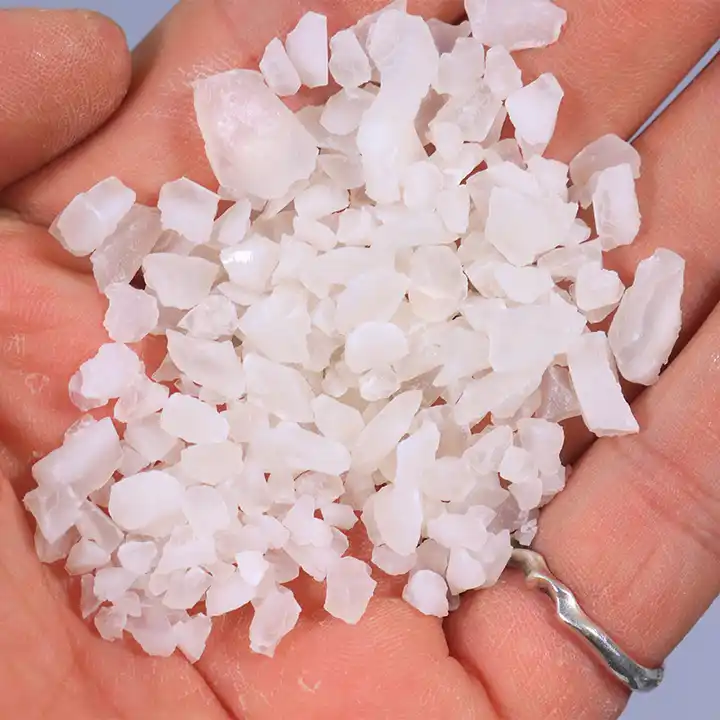When maintaining swimming pool water quality, we often hear the terms polyaluminum chloride and alum. They are both common water purification flocculants, but what are the differences between them? This article will delve into the similarities and differences between polyaluminium chloride and alum in swimming pool water purification to help us better understand how to choose appropriate water treatment methods to ensure clear and transparent swimming pool water quality.

Ⅰ. Characteristics and applications of polyaluminum chloride
A. Definition and composition of polyaluminum chloride
Polyaluminum chloride is an inorganic polymer compound synthesized through the chemical reaction of aluminum chloride and water. Its main component is aluminum chloride, which has a strong oxidizing effect. Due to its polymer structure, polyaluminium chloride has high cohesion properties, making it excellent in water treatment. During this process, aluminum chloride molecules polymerize to form polymer segments, which improves their ability to settle and condense in aqueous solutions.
B. Water treatment mechanism of polyaluminium chloride
Polyaluminum chloride is a new type of water treatment material. Its mechanism of action is that it reacts chemically with impurities in the water. The oxidation of aluminum chloride causes it to precipitate with suspended solids, organic matter, and heavy metal ions in the water. These sediments can be easily filtered out or settled, thus removing impurities from the water. In addition, the polymer structure of polyaluminum chloride also helps to form larger flocs in the water, improving water transparency and purification effect.
C. Application of polyaluminum chloride in swimming pools
Polyaluminum chloride is currently the most commonly used coagulant in swimming pool water. It can quickly and efficiently remove organic matter, bacteria, suspended solids, etc. in the water, making the water clear. Because polyaluminum chloride has good flocculation effect, it can make the floc larger and facilitate filtration. This ensures that the water quality of the swimming pool meets sanitary standards, thereby ensuring safe and clean water quality.
Ⅱ. Characteristics and applications of alum
A. Definition and composition of alum
Alum is a natural potassium aluminum sulfate containing potassium, aluminum, sulfate and other elements. It is extracted from the natural mineral or alunite. The active ingredient in alum is potassium aluminum sulfate, while potassium and sulfate are auxiliary materials. These components enable alum to have better flocculation and precipitation effects.
B. Water treatment mechanism of alum
The main mechanism of alum in water treatment is to act as a flocculant. It promotes the suspended solid particles in the water to combine with each other to form larger flocs through adsorption and bridging. Since these flocs are relatively large, they are more likely to settle to the bottom of the water, thereby achieving the removal of impurities in the water. The flocculation effect of alum makes the water clear and improves the transparency of the water.
C. Application of alum in swimming pools
Alum is also widely used in swimming pool water treatment. It can effectively remove suspended solids, organic matter and other pollutants from the water, ensuring that the swimming pool water quality is clear and transparent. Through flocculation, alum helps form large flocs, making it easier for the filtration system to remove these flocs, keeping the swimming pool water hygienic and safe.
Ⅲ. Similarities and differences between the two
Polyaluminium chloride and alum have many similarities and differences in water purification. First, they differ in composition and mechanism of action. Polyaluminum chloride is mainly used to remove impurities such as suspended solids, organic matter and heavy metal ions in water. Its mechanism of action is to aggregate impurities into larger clumps through flocculation and precipitation, which facilitates subsequent filtration and removal. Alum is mainly used for flocculation and sedimentation. It combines with suspended matter in the water to form larger particles, causing them to settle to the bottom, thereby purifying water quality.
Polyaluminium chloride has some notable features when it comes to swimming pool water treatment. First of all, its price is relatively low, its flocculation and sedimentation speed is fast, and it can adapt to a wide range of pH values. In contrast, alum was an early agent in water purification, and its main component was potassium aluminum sulfate. Polyaluminum chloride is a new type of water purification agent with the characteristics of low dosage and good flocculation effect.
To sum up, polyaluminium chloride and alum, two common chemicals used in swimming pool water treatment, each show unique advantages and applicable scenarios. Due to the macromolecular structure and strong oxidizing ability of polyaluminum chloride, it can effectively remove impurities in water, and is especially useful in the treatment of industrial sewage. In contrast, alum is composed of natural potassium aluminum sulfate and achieves effective water quality improvement through the flocculation mechanism, making it an ideal choice for household tap water purification and swimming pool water treatment.
